You’ll discover stunning colors, attract beneficial pollinators, and support local ecosystems when you choose Tennessee’s native plants for your landscape. These hardy species have adapted to the state’s humid subtropical climate over thousands of years, making them naturally resistant to local pests and weather extremes. Purple Coneflowers bloom from June through September, while Wild Bergamot releases its mint-like fragrance throughout summer months. However, selecting the right combination requires understanding your specific soil conditions and microclimates.
Contents
- 1 Tennessee’s Diverse Ecosystem Overview
- 2 Vibrant Wildflowers for Tennessee Gardens
- 3 Tennessee’s Majestic Canopy Trees
- 4 Tennessee’s Essential Native Shrubs
- 5 Selecting the Right Native Plants for Your Garden
- 6 Frequently Asked Questions
- 6.1 How Often Should I Water Newly Planted Native Tennessee Plants?
- 6.2 When Is the Best Time to Plant Native Species in Tennessee?
- 6.3 Do Tennessee Native Plants Require Special Fertilizers or Soil Amendments?
- 6.4 How Do I Protect Native Plants From Deer and Other Wildlife?
- 6.5 Where Can I Purchase Authentic Tennessee Native Plants and Seeds?
Tennessee’s Diverse Ecosystem Overview
When you explore Tennessee’s landscapes, you’ll discover one of America’s most biodiverse inland states, home to over 3,800 native plant species that thrive across dramatically different environments. You’ll find seven distinct ecoregions, from Blue Ridge Mountains supporting spruce-fir forests to western floodplains hosting moisture-loving plants.
Each region creates unique ecosystem balance through specialized plant adaptation. Temperature gradients and 50-55 inches of annual precipitation support everything from drought-tolerant cedar glade species to lush cove forest communities. Native ferns particularly flourish in these shaded environments, contributing to the understory diversity with their preference for rich, humusy soils and varying moisture levels. Your growing season varies dramatically too, ranging from 160-220 days depending on elevation and location across the state’s diverse terrain.
Vibrant Wildflowers for Tennessee Gardens
Tennessee’s native wildflowers offer stunning beauty while supporting local ecosystems. Choose from pollinator magnets, shade-loving varieties, low-maintenance options, and plants suited for diverse garden settings. These native species play a crucial role in maintaining biodiversity throughout Tennessee’s natural landscapes.
Purple Coneflower (Echinacea Purpurea)
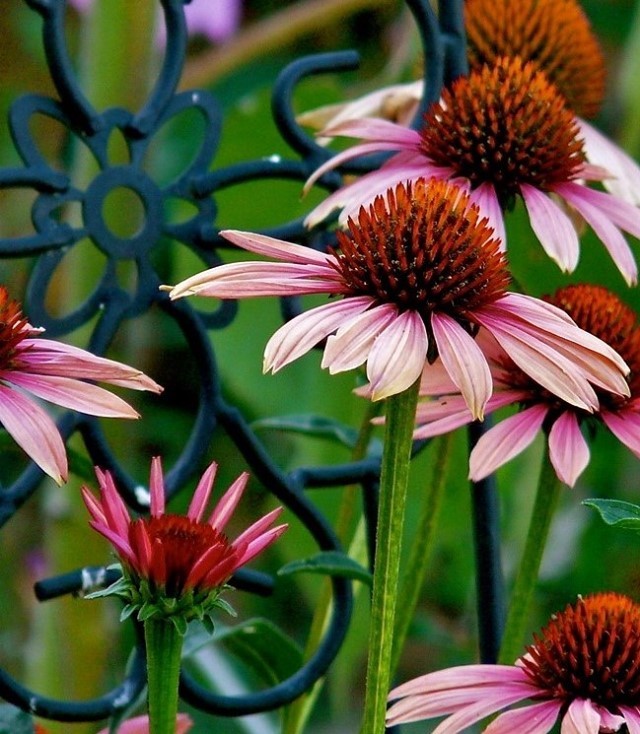
Purple Coneflower (Echinacea purpurea) stands as one of Tennessee’s most beloved native wildflowers, featuring distinctive daisy-like blooms with drooping purple petals surrounding a prominent brown central cone. This hardy perennial develops dark green lance-shaped leaves during its first year while establishing a strong taproot system, followed by abundant flowering in subsequent years.
Beginning in mid-summer, the 2-4 inch diameter flowers create stunning displays that continue sporadically until frost. The plant’s drought tolerance and deer resistance make it invaluable for naturalized meadow settings, prairie-style plantings, and mass border displays, while its distinctive seed heads provide lasting winter interest in the landscape. The flowers serve as an important food source for pollinators including butterflies and other beneficial insects, while birds such as finches are attracted to the nutritious seeds.
- Hardiness: USDA zones 3-9, depending on species
- Light: Full sun preferred, tolerates partial shade; requires 6-8 hours daily sunlight for ideal blooming
- Water: Average moist to dry conditions; drought-tolerant once established but needs protection during first year
- Soil: Well-draining soils; thrives in average conditions
- Fertilizer: Benefits from compost or aged manure mixed into planting area
- Pest/Disease Resistance: Deer-resistant; avoid overhead irrigation to prevent foliar diseases
- Growth Rate: Moderate; produces basal leaves first year, begins flowering in second year
Black-Eyed Susan (Rudbeckia Hirta)
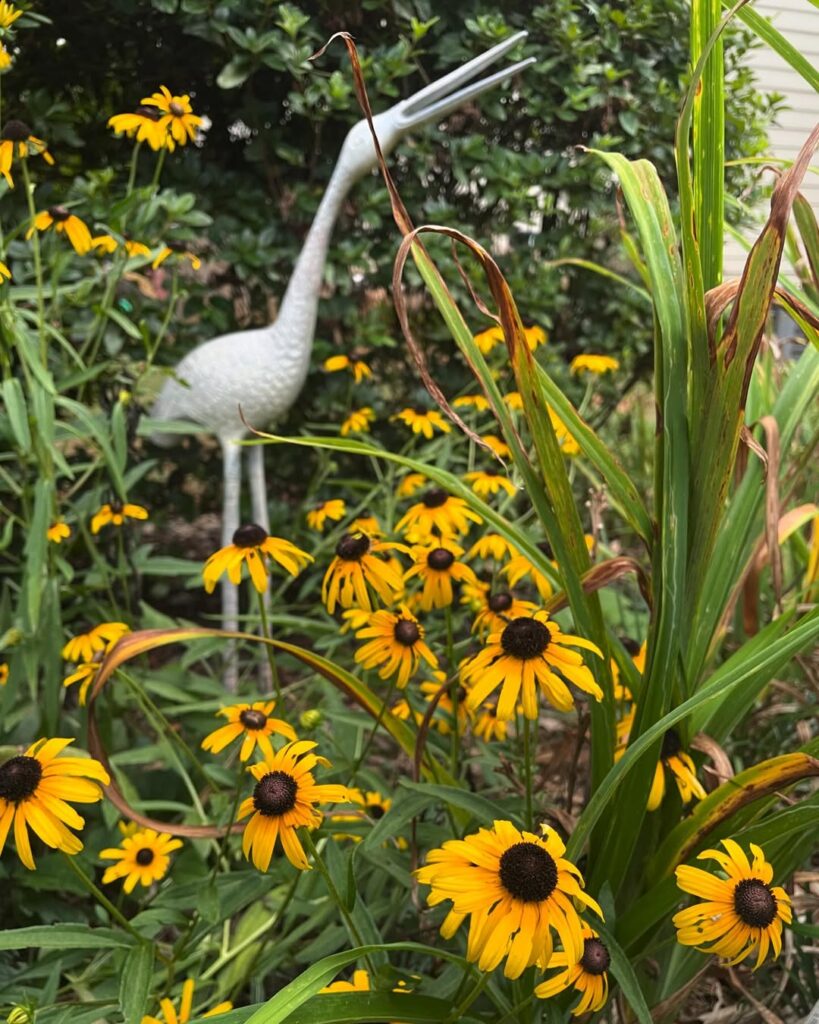
Black-Eyed Susan (Rudbeckia hirta) is a cheerful native wildflower that brings bright golden-yellow blooms with distinctive dark brown centers to Tennessee landscapes. Growing 3-4 feet tall with daisy-like flowers measuring 2-3 inches across, this drought-tolerant plant features bristly stems and leaves that give it a characteristic rough texture. Native to Middle and East Tennessee, it thrives in prairies, meadows, and woodland edges.
This adaptable wildflower attracts butterflies and birds while providing excellent pollinator habitat. Black-Eyed Susan readily self-seeds for natural propagation, though this vigorous spreading may require management in formal garden settings. Its coarse, natural appearance makes it ideal for prairie-style plantings and naturalized areas where its striking summer display can shine. The plant produces a striking floral display that creates visual impact throughout the growing season.
- Hardiness: Functions as annual, biennial, or short-lived perennial depending on conditions
- Light: Full sun to partial sun
- Water: Moderately wet to dry; drought tolerant once established
- Soil: All soil types except coarse rocky soil; slightly acidic to neutral pH
- Fertilizer: Low maintenance; no supplemental fertilizer needed
- Pest/Disease Resistance: Generally resistant with few serious issues
- Growth Rate: Moderate to fast; readily self-seeds for natural spread
Wild Bergamot (Monarda Fistulosa)

Wild Bergamot (Monarda fistulosa) is a stunning native wildflower that brings vibrant color and fragrance to Tennessee gardens. Growing up to 5 feet tall, this aromatic perennial produces clusters of ragged, pompom-like flowers in shades of lavender, pink, or white from June through August. Its gray-green leaves emit a delightful minty scent, making it both visually appealing and sensory-rich.
This hardy native spreads readily to form beautiful naturalized areas and serves as an exceptional pollinator magnet, attracting bees, butterflies, and hummingbirds throughout its long blooming season. The plant produces distinctive brown nutlets as its fruit, which develop after the blooming period ends. Also known as Bee Balm or Purple Bergamot, Wild Bergamot has historical significance as a traditional tea plant and medicinal herb, adding cultural value to its ornamental appeal.
- Hardiness: Native to most of North America, well-adapted to Tennessee’s climate zones
- Light: Full sun (6+ hours daily) preferred, tolerates partial shade
- Water: Moist soil during establishment year, then drought tolerant once established
- Soil: Well-drained loamy or sandy soil preferred; adaptable to rocky and clay soils with good drainage; pH 6.0-7.5
- Fertilizer: Low maintenance, typically does not require supplemental fertilizing
- Pest/Disease Resistance: Naturally deer resistant, generally pest-free
- Growth Rate: Fast-spreading, readily forms large colonies
Wild Columbine (Aquilegia Canadensis)
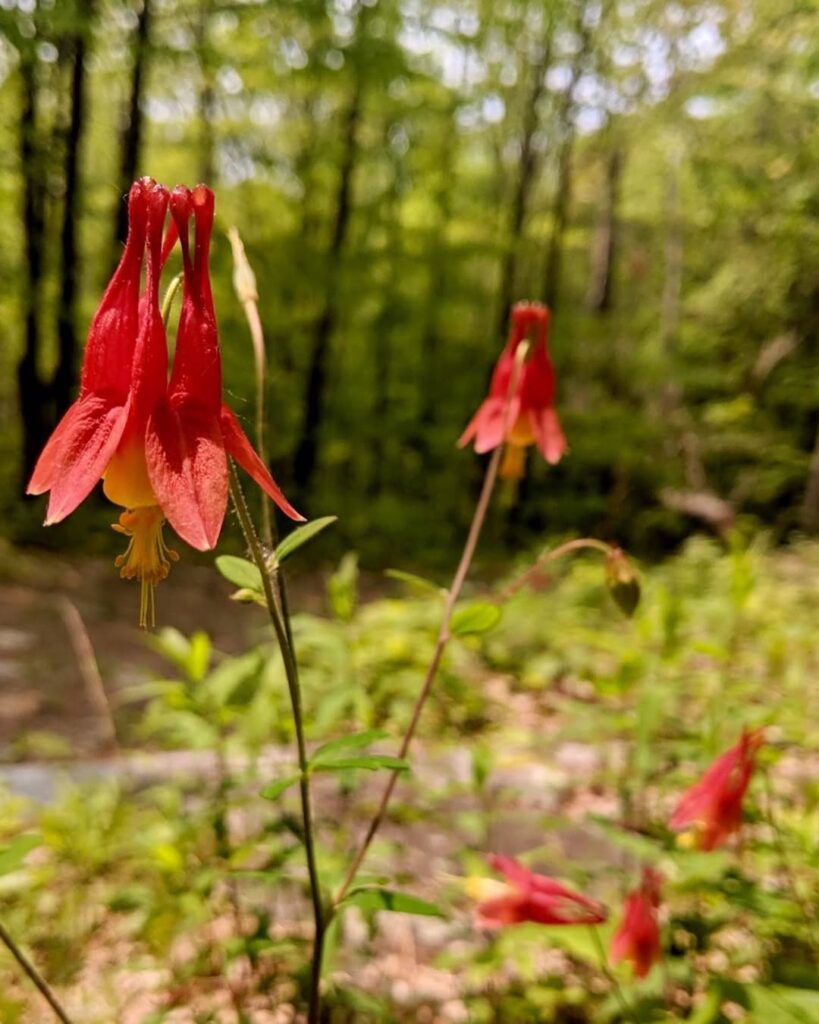
Wild Columbine (Aquilegia canadensis) is a charming native perennial wildflower that brings vibrant red and yellow bell-shaped blooms to Tennessee gardens each spring. Growing 2-3 feet tall, this member of the buttercup family produces distinctive nodding flowers approximately 1.5 inches in size that serve as vital early-season nectar sources for hummingbirds and native pollinators.
This adaptable wildflower thrives in various garden settings, from woodland borders to cottage gardens, and readily self-seeds in favorable locations. Its ability to tolerate diverse growing conditions while supporting native wildlife makes it an excellent choice for naturalized areas and shade gardens throughout Tennessee. In particularly favorable locations, Wild Columbine can develop into attractive groundcover, creating natural drifts of spring color.
- Hardiness: USDA zones 3-8
- Light: Full sun to full shade; prefers light to moderate shade
- Water: Medium to dry moisture levels; prefers moist conditions
- Soil: Various soil types; prefers rich, well-draining soils with neutral to slightly alkaline pH
- Fertilizer: Low maintenance; no special fertilizer requirements
- Pest/Disease Resistance: Generally good resistance; few serious pest or disease issues
- Growth Rate: Moderate; long-lived perennial that spreads gradually over time
Tennessee Coneflower (Echinacea Tennesseensis)

The Tennessee Coneflower stands as one of the state’s most remarkable native wildflowers, endemic exclusively to the central cedar glades of Tennessee. This herbaceous perennial produces distinctive purple-pink blooms with characteristically upright ray petals, contrasting with the drooping petals of other Echinacea species. Growing up to 75 cm tall, it blooms from June through August, creating stunning displays in its natural limestone habitat.
Once listed as endangered, this resilient wildflower has made a remarkable recovery through dedicated conservation efforts and has been recently removed from the federal endangered species list. Its drought tolerance and ability to thrive in challenging rocky conditions make it an excellent choice for native plant gardens and xeriscaping. The Tennessee Coneflower attracts butterflies, native bees, and hummingbirds while providing vital late-summer nectar sources for pollinators.
- Hardiness: USDA zones 5-8
- Light: Full sun
- Water: Low to moderate; drought-tolerant once established
- Soil: Well-drained, rocky, sandy, or limestone-derived soils; poor to average fertility
- Fertilizer: None required; avoid rich soils
- Pest/Disease Resistance: Excellent resistance to most pests and diseases
- Growth Rate: Moderate; long-lived perennial
Tennessee’s Majestic Canopy Trees
Tennessee’s native canopy trees create stunning overhead landscapes while providing essential wildlife habitat, erosion control, and urban cooling benefits across diverse soil conditions and elevations. These magnificent trees can reach impressive heights, with some species like White Oak and Sycamore achieving mature sizes of 80 to 100 feet tall and wide.
Eastern Red Cedar (Juniperus Virginiana)

Eastern Red Cedar is Tennessee’s most widely distributed native conifer, recognized for its distinctive evergreen, aromatic foliage and columnar growth habit. This versatile tree typically reaches 30-40 feet tall with scale-like leaves that range from gray-green to blue-green, bronzing in winter. Female trees produce characteristic pale blue berries with waxy coatings that provide vital winter food for birds.
The species demonstrates remarkable adaptability, thriving in diverse conditions from disturbed sites to established forests. Its aromatic, insect-repelling wood has made it valuable for cedar chests, fence posts, and pencil manufacturing, while its ecological importance includes serving as a seed dispersal system through birds and providing habitat in cedar barrens ecosystems. This native conifer is found across 37 states throughout the United States, making it one of the most widespread evergreen trees in North America.
- Hardiness: Extremely hardy, resistant to drought, heat, and cold extremes
- Light: Full sun to partial shade
- Water: Drought tolerant once established, moderate water needs
- Soil: Adaptable to various soil types, prefers deep, moist, well-drained alluvial sites
- Fertilizer: Low fertilizer requirements, thrives in poor soils
- Pest/Disease Resistance: Generally resistant, serves as alternate host for cedar-apple rust
- Growth Rate: Moderate to slow growth rate
Tulip Tree (Liriodendron Tulipifera)
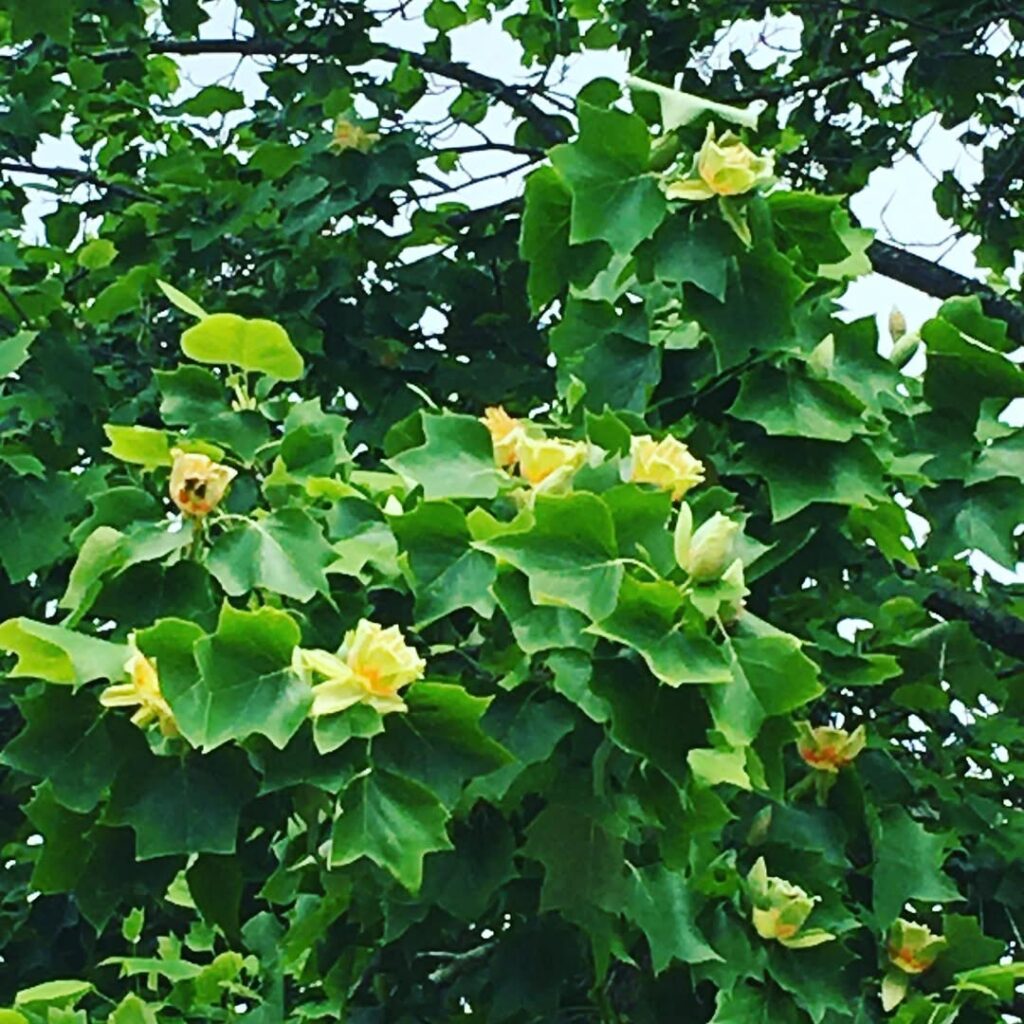
The Tulip Tree stands as Tennessee’s magnificent state tree and the tallest native eastern hardwood, capable of reaching heights over 160 feet. Distinguished by its unique tulip-shaped leaves with three to four lobes and striking cup-shaped flowers featuring greenish-yellow petals with orange bands, this majestic species creates an impressive canopy presence in both forest and urban settings.
Beyond its ornamental value, the Tulip Tree serves as an ecological powerhouse, providing essential habitat and nectar sources for pollinators while supporting diverse wildlife. Its rapid growth rate and minimal maintenance requirements make it perfect for large-scale landscaping, while the commercially valuable “yellow-poplar” timber has supported regional economies for generations. With golden autumn foliage and a lifespan extending up to 300 years, this adaptable native offers both immediate impact and long-term benefits. The tree’s trunk can develop an impressive 4-6 feet diameter, creating magnificent specimens that dominate the landscape.
- Hardiness: Zones 4-9, extremely cold tolerant and adaptable to Tennessee’s climate variations
- Light: Full sun to partial shade, performs best with at least 6 hours of direct sunlight
- Water: Moderate to high water needs, thrives in consistently moist but well-drained conditions
- Soil: Prefers deep, rich, moist soils but adaptable to various soil types with good drainage
- Fertilizer: Low fertilizer requirements, benefits from organic matter and mulching around base
- Pest/Disease Resistance: Excellent resistance with minimal pest issues, low maintenance requirements
- Growth Rate: Rapid growth rate, especially in ideal forest cove conditions with rich soils
White Oak (Quercus Alba)
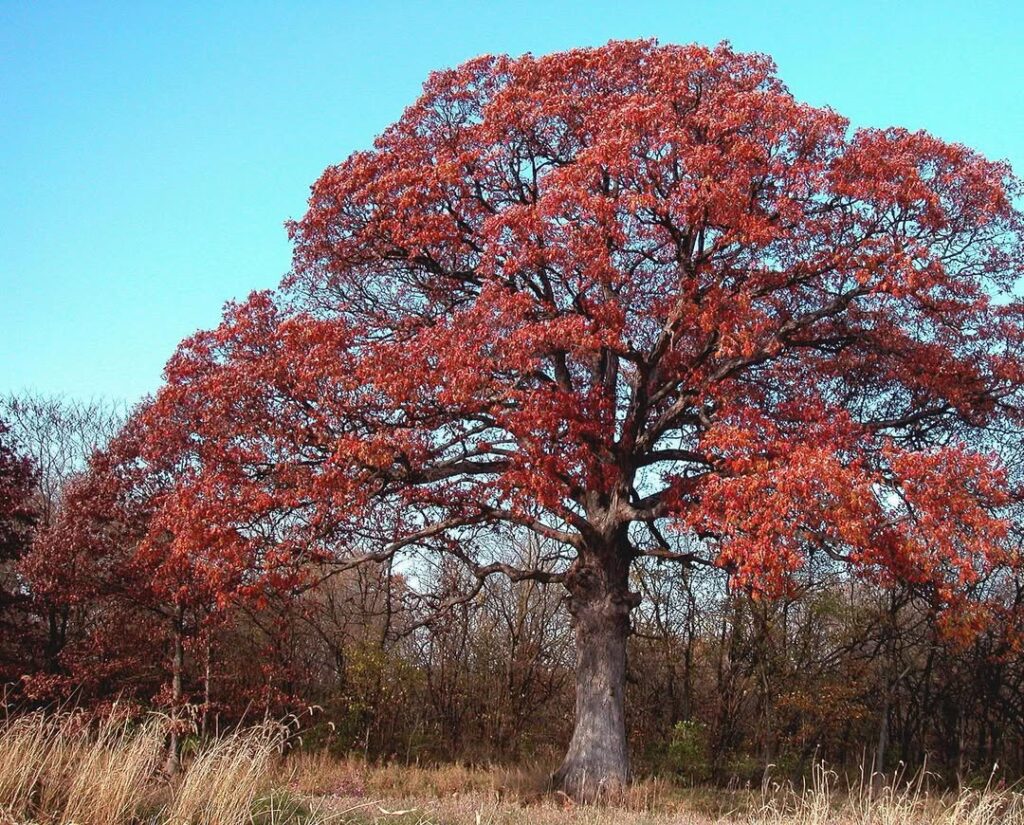
The White Oak (Quercus alba) stands as one of Tennessee’s most magnificent native trees, reaching impressive heights of 80-100 feet with a massive canopy that provides exceptional habitat value. Distinguished by its light ash-gray bark that peels naturally and glossy leaves measuring 2-3 inches long, this deciduous giant produces white spring flowers followed by acorns that serve as vital wildlife food sources.
With an average lifespan of 200-300 years, White Oaks develop into imposing specimens with straight trunks and wide crowns when grown in open areas. As the most important lumber tree of the white oak group, it offers both ecological and economic value while demonstrating remarkable disease resistance that contributes to long-term ecosystem stability. The wood’s natural tyloses create a closed cellular structure that enhances leak resistance, making it particularly valuable for traditional wine and whiskey barrel production.
- Hardiness: USDA zones 3-8, adaptable to zones 9-11
- Light: Full sun preferred
- Water: Medium to dry moisture levels; drought tolerant once established
- Soil: Adaptable to various soil types including heavy clay, sandy, and sandy loam; best growth on deep, fertile loam
- Fertilizer: Generally not required; thrives in native soil conditions
- Pest/Disease Resistance: Excellent resistance to diseases and pests
- Growth Rate: Moderate to slow; forest specimens grow taller while open-area trees develop broader forms
Sugar Maple (Acer Saccharum)
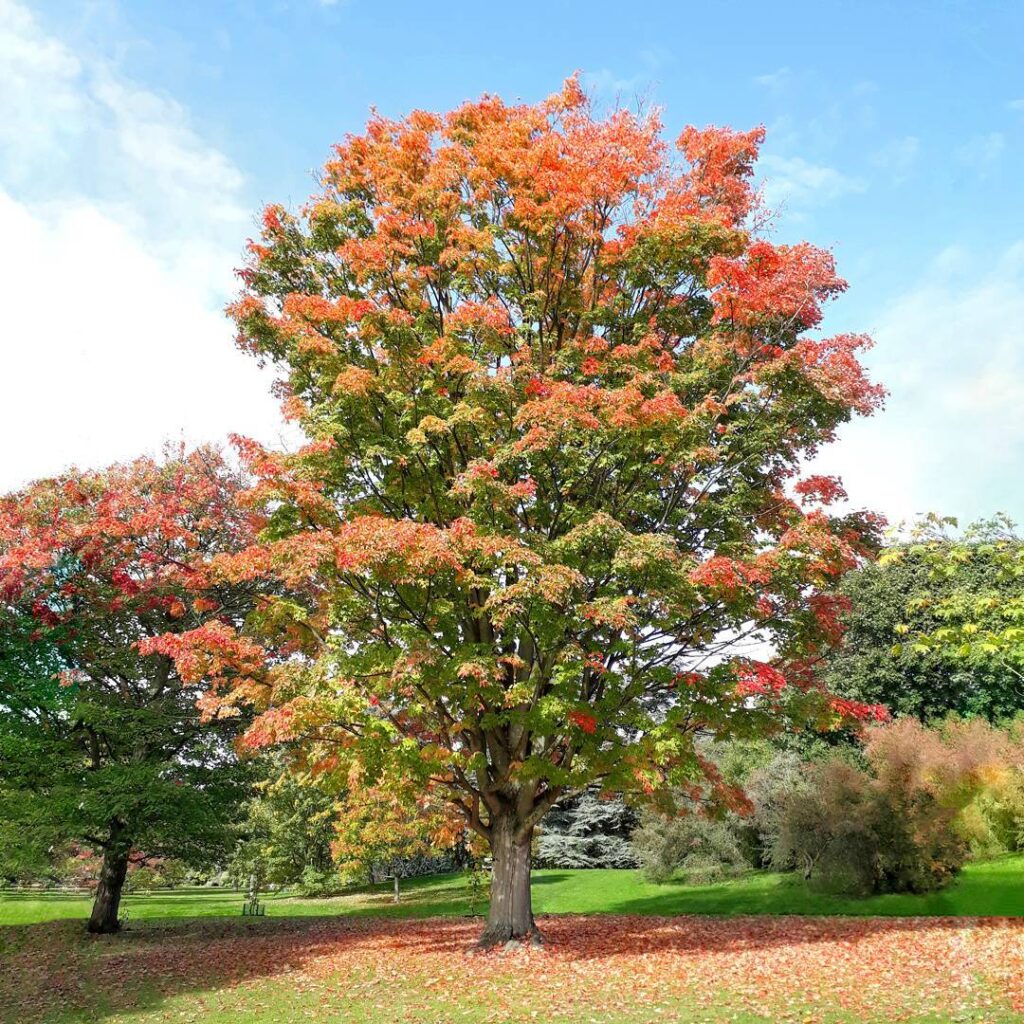
Sugar Maple (Acer saccharum) stands as one of Tennessee’s most magnificent native canopy trees, renowned for its spectacular autumn foliage and ecological importance. This shade-tolerant hardwood thrives in the state’s eastern regions, particularly in rich cove forests and wooded slopes at elevations between 3,000-5,500 feet.
Distinguished by its preference for well-drained, mineral-rich soils containing magnesium, iron, and lime, Sugar Maple serves as both an understory species and dominant canopy tree. Its adaptability to varying light conditions makes it invaluable for forest succession, while its intolerance of wet or sandy soils limits its placement in landscape settings. These remarkable trees can live for 200 to 300 years, making them a truly long-term investment in Tennessee’s forest heritage.
- Hardiness: Zones 3-8, well-suited to Tennessee’s eastern uplands and mountainous regions
- Light: Shade tolerant to full sun, thrives in filtered light with ability to respond to canopy gaps
- Water: Moderate moisture requirements, prefers consistent soil moisture without waterlogging
- Soil: Well-drained, rich mesic soils high in magnesium, iron, and lime; avoid sandy or swampy conditions
- Fertilizer: Minimal requirements when planted in appropriate native soil conditions
- Pest/Disease Resistance: Generally robust with good resistance to most common pests and diseases
- Growth Rate: Moderate to slow, establishing strong root systems before rapid vertical growth
American Chestnut (Castanea Dentata)

The American chestnut was once the dominant canopy tree throughout Tennessee’s Appalachian forests, reaching heights over 100 feet with massive trunks and broad, rounded crowns. As a member of the beech family, these fast-growing deciduous trees were ecological powerhouses, supporting vast food webs through their prolific nut production and providing critical habitat for wildlife including squirrels, deer, bears, and turkeys.
Tragically, the species was devastated by chestnut blight in the early 20th century, which killed billions of trees and rendered the American chestnut functionally extinct as a canopy species. Today, only small sprouts from old root systems persist, rarely reaching maturity before succumbing to the blight. Restoration efforts are ongoing, focusing on developing blight-resistant varieties to eventually return this majestic tree to Tennessee’s forests. The Darling 58 cultivar incorporates a wheat gene that produces oxalate oxidase enzyme, potentially offering the first viable solution to restore these magnificent trees to the wild.
- Hardiness: Zones 4-8, well-adapted to Tennessee’s climate
- Light: Full sun to partial shade; thrives in open canopy conditions
- Water: Moderate moisture requirements; prefers consistent but not waterlogged conditions
- Soil: Moist, well-drained upland soils; tolerates various soil types but prefers rich, slightly acidic conditions
- Fertilizer: Generally not required in native forest settings; benefits from organic matter
- Pest/Disease Resistance: Highly susceptible to chestnut blight; also vulnerable to ink disease in southern regions
- Growth Rate: Fast-growing, can reach 35 feet in 20 years under ideal conditions
Tennessee’s Essential Native Shrubs
Tennessee’s diverse climate supports numerous native shrubs that provide year-round beauty, wildlife habitat, and low-maintenance landscaping solutions across various soil conditions and sun exposures. These hardy plants are naturally adapted to local environmental conditions, eliminating the need for excessive watering or chemical treatments while creating sustainable garden ecosystems.
Spicebush (Lindera Benzoin)
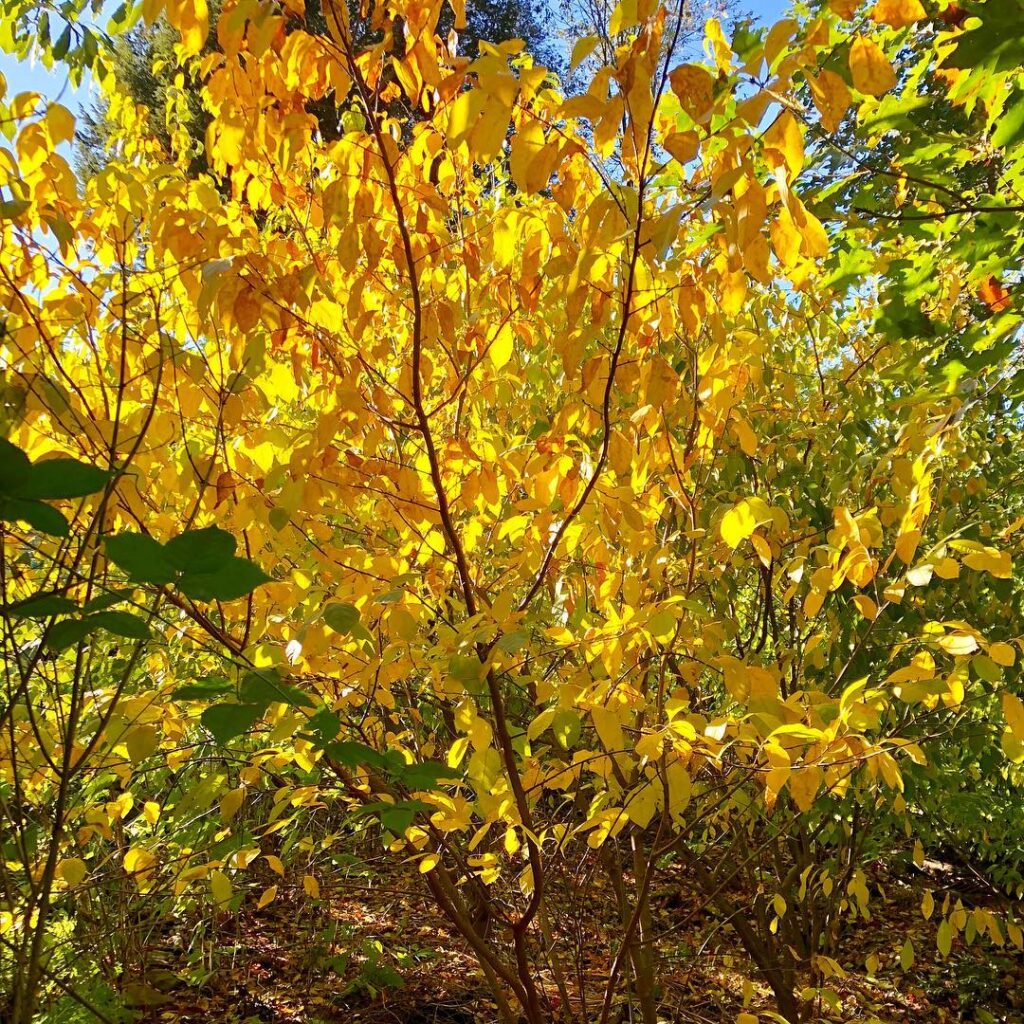
Spicebush (Lindera benzoin) is a deciduous native shrub that grows 6-15 feet tall and wide with glossy green leaves and aromatic stems. This Tennessee native produces clusters of small yellow-green flowers in early spring before leaves emerge, followed by bright red berries in fall that provide food for migrating songbirds.
This versatile shrub serves as a host plant for both Spicebush and Palamedes Swallowtail butterflies while offering year-round landscape interest. Its fragrant leaves and stems release a spicy scent when crushed, and the plant has traditional uses in teas and as a spice substitute, earning it the common name Wild Allspice. The foliage transforms into brilliant golden-yellow colors in autumn, adding seasonal beauty to the landscape.
- Hardiness: Hardy throughout Tennessee’s climate zones
- Light: Partial shade to full shade, woodland conditions
- Water: Moderate moisture, drought tolerant once established
- Soil: Well-draining, adaptable to various soil types
- Fertilizer: Low maintenance, no regular fertilization needed
- Pest/Disease Resistance: Generally pest and disease free
- Growth Rate: Slow growth rate with rounded habit
Elderberry (Sambucus Canadensis)
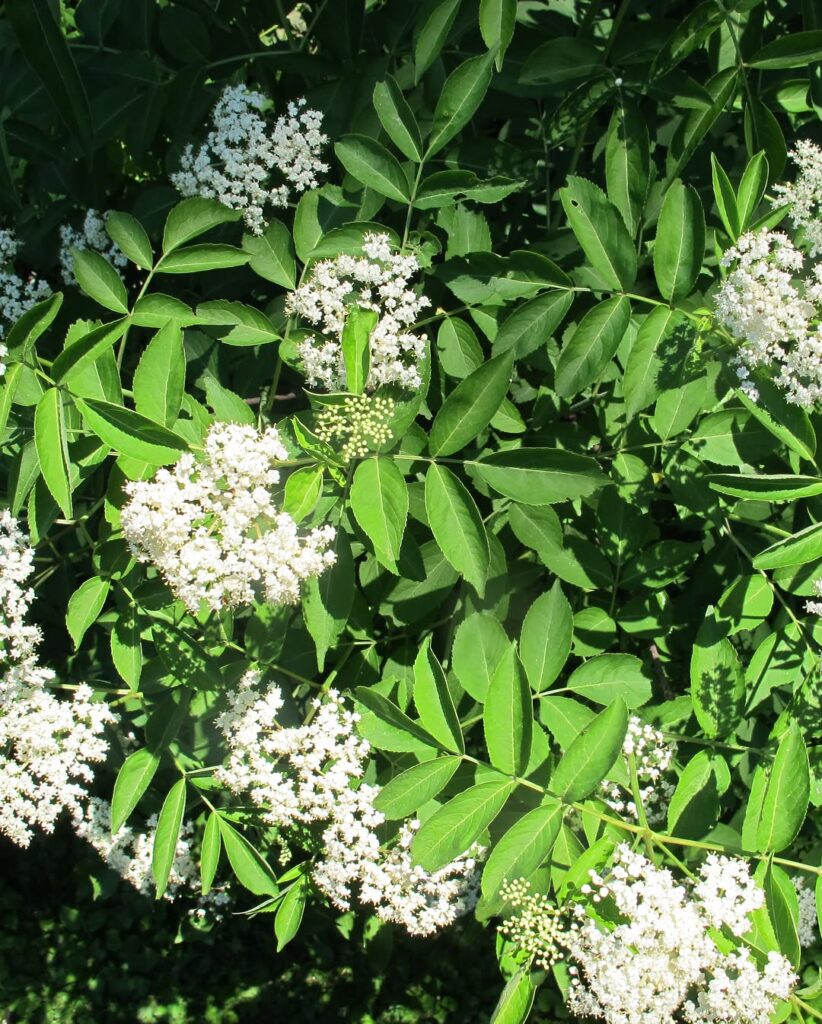
Elderberry (Sambucus canadensis) is a versatile native deciduous shrub that thrives throughout Tennessee’s diverse climate zones. This multi-stemmed plant grows 5-12 feet tall with graceful arching branches, producing showy clusters of white flowers in late spring followed by dark purple berries in late summer. Beyond its ornamental value, elderberry offers edible flowers and berries that can be used for culinary purposes, while providing essential habitat and food sources for native wildlife.
As a Tennessee native, elderberry adapts well to various landscape conditions and requires minimal maintenance once established. Its compound leaves and fibrous root system make it suitable for naturalized areas, pond edges, and mixed shrub borders. The plant features distinctive yellowish-gray bark with white pith that helps with identification. The plant’s multi-season interest and ecological benefits make it an excellent choice for gardeners seeking both beauty and functionality in their landscapes.
- Hardiness: USDA zones 4a-8b (covers all Tennessee regions)
- Light: Full sun to partial shade (2-6 hours direct sunlight)
- Water: Moist, well-drained conditions; tolerates occasionally wet soil
- Soil: Adaptable to clay, loam, sand, and organic-rich soils; pH 5.5-8.0
- Fertilizer: Low requirements as native plant; benefits from organic matter
- Pest/Disease Resistance: Generally resistant with few serious issues
- Growth Rate: Medium growth rate with fibrous, shallow root system
Ninebark (Physocarpus Opulifolius)
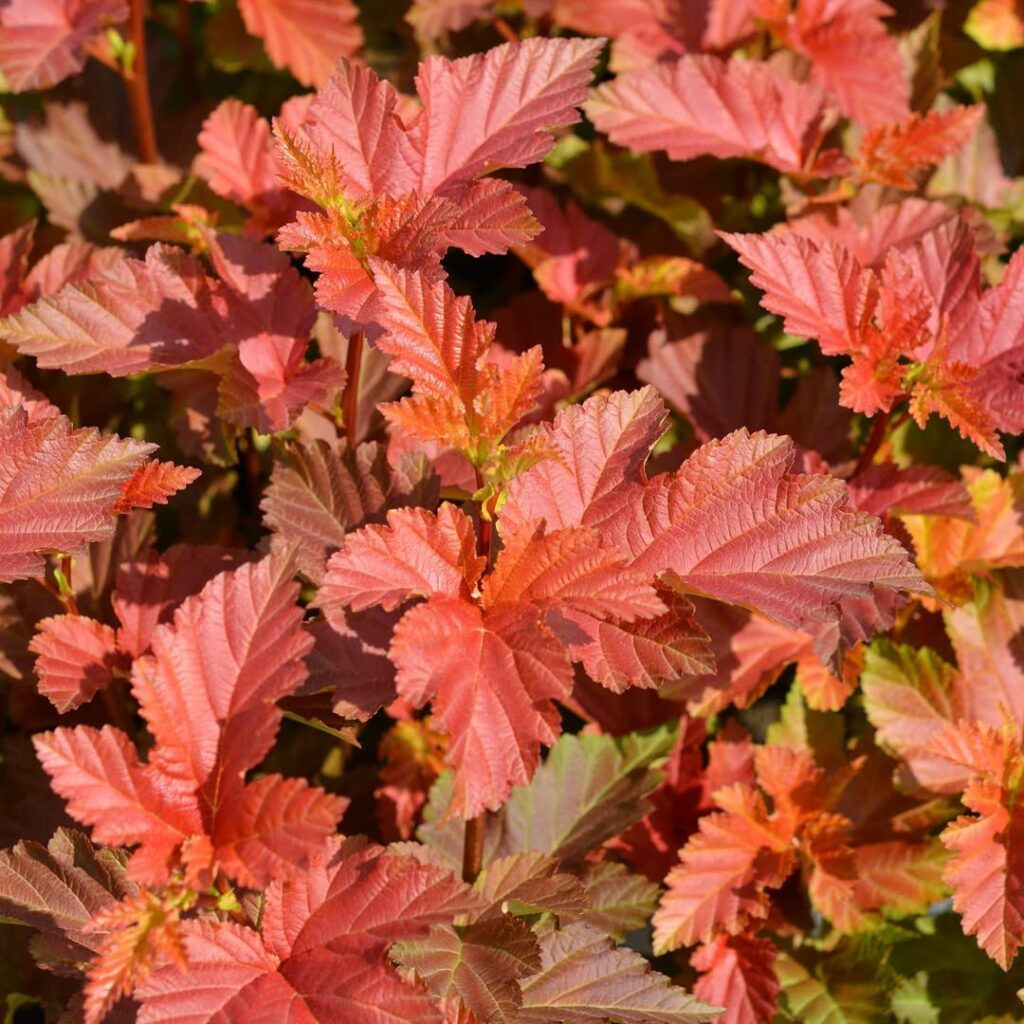
Ninebark is a versatile deciduous shrub native to Tennessee, growing 5-9 feet tall with an attractive mound-shaped habit. This adaptable plant features delicate white to pinkish flower clusters in late spring, distinctive peeling bark that reveals reddish-brown layers, and seasonal foliage changes that provide year-round interest.
Beyond its ornamental value, ninebark serves important ecological functions as a host plant for moths and attracts native pollinators including bees and butterflies. Its low-maintenance nature and exceptional adaptability to various soil and light conditions make it ideal for naturalizing landscapes, erosion control, or use as a specimen plant in Tennessee gardens. The plant produces papery capsule fruits that start bright red before turning brown, adding additional seasonal interest to the landscape.
- Hardiness: Zones 2-7, highly resilient to weather extremes
- Light: Full sun to shade, showcasing high adaptability
- Water: Tolerates wide range from moderately wet to dry conditions
- Soil: Adaptable to various soil types including clay, rocky, and poor soils
- Fertilizer: Minimal requirements, thrives without supplemental feeding
- Pest/Disease Resistance: Naturally resistant under normal growing conditions
- Growth Rate: Moderate, reaching mature size of 5-9 feet height and 4-6 feet spread
Aromatic Sumac (Rhus Aromatica)
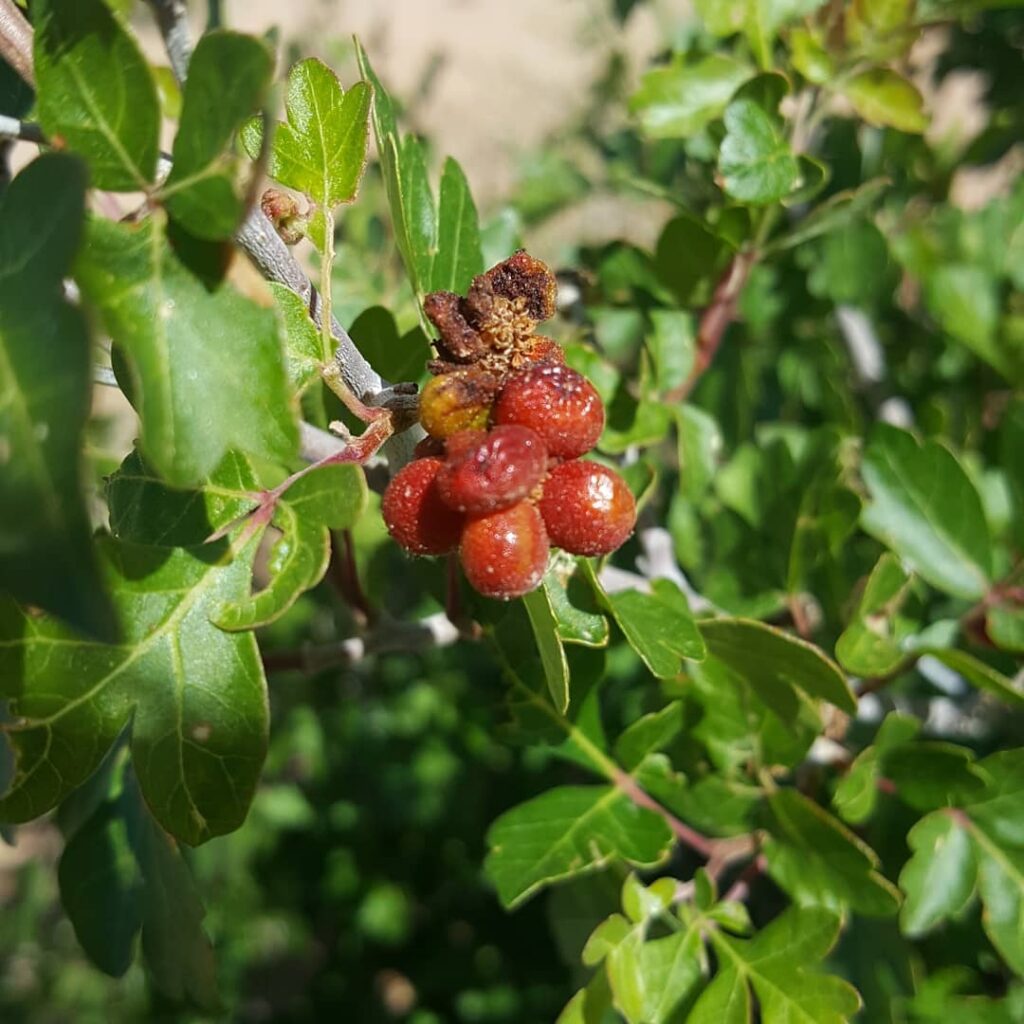
Aromatic Sumac (Rhus aromatica) is a versatile native Tennessee shrub that offers exceptional adaptability and year-round interest. This spreading deciduous plant reaches 2-6 feet tall with distinctive blue-green trifoliate leaves and produces yellowish catkin flowers in early spring. The shrub develops clusters of dark-red berries and spectacular fall colors ranging from orange to purple.
Known for its lemony-scented foliage when crushed, Aromatic Sumac excels in challenging growing conditions where other plants struggle. Its drought tolerance and ability to thrive in poor soils make it invaluable for erosion control and naturalized plantings. The edible berries provide wildlife value and can be used to make invigorating beverages, while the plant’s manageable spreading habit makes it less aggressive than other sumac species. This shrub demonstrates high deer resistance, making it particularly valuable in areas where browsing pressure limits other plantings.
- Hardiness: Cold hardy to -40°F with high heat tolerance
- Light: Full sun to partial shade
- Water: Drought tolerant; adapts to moist or dry conditions
- Soil: Well-drained soils; tolerates clay, rocky, shallow, and acidic soils
- Fertilizer: No fertilizer needed; thrives in poor soil conditions
- Pest/Disease Resistance: Excellent resistance to pests and diseases
- Growth Rate: Moderate growth rate with natural spreading ability
Flowering Dogwood (Cornus Florida)
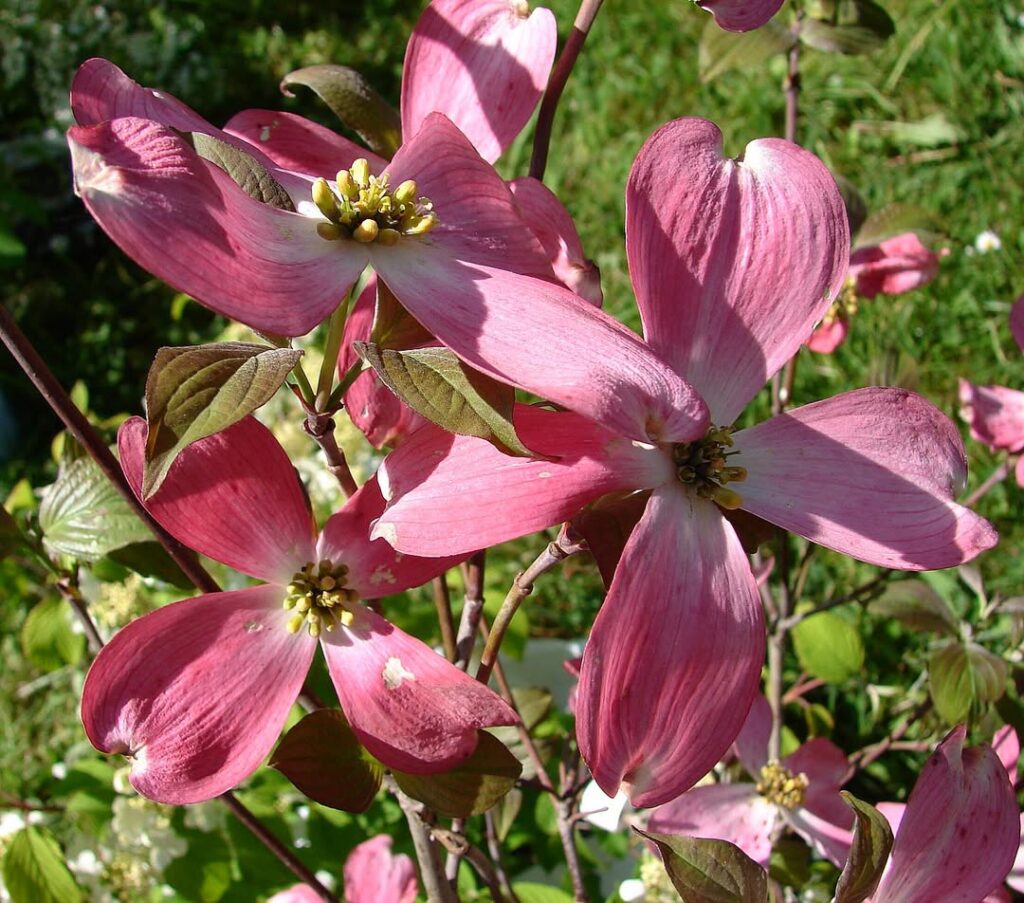
The Flowering Dogwood is Tennessee’s beloved native tree, reaching 15-25 feet with a distinctive low-branched canopy. Its showy white or pink bracts create spectacular spring displays, followed by bright red berries that persist through winter. This iconic species provides year-round interest and serves as an excellent specimen or shade tree.
Naturally occurring throughout eastern North America, the Flowering Dogwood thrives in woodland settings and holds deep cultural significance in Tennessee. Its four-season appeal, wildlife value, and adaptability to various landscape uses make it indispensable for native plant gardens seeking authentic regional character. The tree serves as a host plant for the spring Azure butterfly, with its blooms also attracting various other butterfly species to the garden.
- Hardiness: USDA zones 5A through 9A
- Light: Partial shade to full sun, best in light shade
- Water: Consistent moisture; struggles in drought conditions
- Soil: Well-drained, moist soils; avoid dry upper slopes and ridges
- Fertilizer: Minimal requirements in appropriate soil conditions
- Pest/Disease Resistance: Vulnerable to dogwood anthracnose in some locations
- Growth Rate: Moderate
Selecting the Right Native Plants for Your Garden
When you’re choosing native plants for your Tennessee garden, you’ll want to match each species to your specific growing conditions rather than simply picking the prettiest options. Consider your soil moisture, sunlight exposure, and space requirements first. For shaded woodland areas, select Trillium species or Dryopteris ferns. Full sun locations work well for Sunburst Helianthus varieties and drought-tolerant Lemon Mint. Native plant benefits include reduced maintenance and stronger pest resistance in your garden design. Match wet areas with Marsh Marigold, while Woodland Phlox ‘Blue Moon’ thrives in partial shade conditions throughout Tennessee. Tennessee’s botanical diversity extends from the Appalachian Mountains to the Mississippi floodplains, providing gardeners with an exceptional range of native species to choose from.
Frequently Asked Questions
How Often Should I Water Newly Planted Native Tennessee Plants?
Your newly planted natives are absolutely thirsting for attention! You’ll need twice-weekly watering frequency until they’re established. Deep morning watering promotes excellent moisture retention and develops strong root systems for future drought resistance.
When Is the Best Time to Plant Native Species in Tennessee?
Fall planting offers you the best conditions for establishing native Tennessee species. You’ll get ideal results planting September through October, though spring planting after the final frost also works well for many varieties.
Do Tennessee Native Plants Require Special Fertilizers or Soil Amendments?
You’re overthinking native plant care like a helicopter parent—Tennessee’s natives are self-sufficient champions. They’ll thrive in your existing soil composition without special fertilizers or amendments, having evolved perfectly for local conditions.
How Do I Protect Native Plants From Deer and Other Wildlife?
You’ll need effective deer repellents like homemade egg-based sprays and strong-scented plants. Install fencing options including eight-foot barriers or electric fences with peanut butter. Use motion-activated sprinklers and rotate pinwheels for additional deterrence.
Where Can I Purchase Authentic Tennessee Native Plants and Seeds?
You’ve struck gardening gold! Purchase authentic Tennessee natives from local nurseries like Tennessee Naturescapes and GroWild, or explore online retailers such as TN Nursery and Native Wildflowers Nursery for convenient shipping options.
